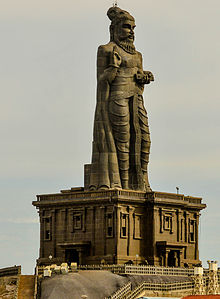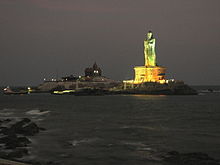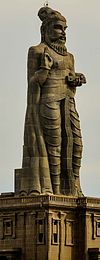Thiruvalluvar Statue
திருவள்ளுவர் சிலை | |
 Thiruvalluvar Statue in Kanyakumari | |
 | |
| 8°04′40″N77°33′14″E/ 8.0777°N 77.5539°E | |
| Location | Kanyakumari,Tamil Nadu,India |
|---|---|
| Designer | V. Ganapati Sthapati |
| Type | Monument (statue) |
| Material | Stoneandconcrete |
| Height | 40.6 m (133 ft) |
| Beginning date | 7 September 1990 |
| Completion date | 1999 |
| Opening date | 1 January 2000 |
| Dedicated to | Valluvar,author of theKural text |
TheThiruvalluvar Statue,or theValluvar Statue,is a 41-metre-tall(133 ft) stone sculpture of theTamilpoet and philosopherValluvar,known as Thiruvalluvar, the author of theThirukkural,an ancient Tamil work onDharmaandmorality.It is located atop a small island near the town ofKanniyakumarion the southernmost point of theIndian peninsulain the state Tamil Nadu, India, where two seas (theBay of Bengaland theArabian Sea) and an ocean (theIndian Ocean) meet. The statue was sculpted by Indian sculptorV. Ganapati Sthapati,who also created theIraivan Temple,and was unveiled on the millennium day of 1 January 2000 by the then Chief MinisterM. Karunanidhi.It is currently the 25th tallest statue in India.
Description
[edit]
The combined height of the statue and pedestal is 133 feet (41 metres), denoting the 133 chapters of the Thirukkural. This includes 95 feet (29 metres) sculpture of Valluvar standing upon a 38 feet (12 metres) pedestal that represents the 38 chapters ofVirtue,the first of the three books of the Kural text. The statue itself represents the second and third books of the Kural text, namely,WealthandLove.The whole design signifies that wealth and love be earned and enjoyed on the foundation of solid virtue.[1]The right hand of the statue with three fingers pointing skywards signifies the three cantos of the Kural text, namely,Aram,Porul,andInbam(Virtue, Wealth, and Love, respectively), combined.[2]The head of the statue stands at a height of 61 metres (200 ft) above thesea level.[3]
The statue, with its slight bend around the waist is reminiscent[citation needed]of a dancing pose of theHindudeities likeNataraja.The statue weighs 7,000 tonnes (6,900 long tons; 7,700 short tons).[4]

The monument is regarded as a cultural fusion because of its juxtaposition beside theVivekananda Rock Memorial.Built-in conformation with traditionalIndian architecture,the statue has provision to provide a hollow portion inside from toe to scalp. Visitors, however, will not be allowed to scale, but instead be permitted to climb up to the foot of the statue at a height of 12 metres (38 ft).[2]
Construction
[edit]
On 15 April 1979, the then Prime MinisterMorarji Desailaid the foundation stone for the statue, in the presence of the then Chief Minister,M. G. Ramachandran.[2]However, the actual sculpting work, led by Dr. V. Ganapati Sthapathy, former principal of the Government College of Architecture atMahabalipuram,[3]began a decade later on 6 September 1990, on the tiny island adjacent to theVivekananda Rock Memorialwhen funds were allocated in the 1990–91 budget.[2]
Sthapathy was chosen for the project over 300 master builders because his suggestion for an all-stone monument to the poet-philosopher prevailed. He observed that stone would be more durable than metal, citing that theStatue of Liberty,which is made ofcopper,required extensive renovation just a century after its installation. Initially, the project stalled, perhaps owing to Karunanidhi's election loss, but then recommenced in 1997 when he returned to office.[3]At the cost of more than₹61.4 million(equivalent to₹260 million or US$3.2 million in 2023), the project employed about 150 workers,sculptors,assistants and supervisors, who worked about 16 hours a day to complete the work.[3]
The bend around the waist depicting a dance pose made the design challenging. However, the problem was tackled well in advance by the sculptor by creating a full-length woodenprototypebefore construction. Study of this prototype led to the identification of an energy line (known inVastuaskayamadhyasutra), currently an empty cavity in the center of the statue from top to bottom.[3]
The stonework was divided amongst three workshops, inKanniyakumari,AmbasamudramandSholinganallur.Ambasamudram contributed 5,000 tonnes (4,900 long tons; 5,500 short tons) of stones, while Sholinganallur was quarried for 2,000 tonnes (2,000 long tons; 2,200 short tons) of high-qualitygranitestones for the outer portion of the statue. While the largest of the 3,681 stones were 4 metres (13 ft) long and weighed over 15 tonnes (15 long tons; 17 short tons), the majority weighed 3 to 8 tonnes (3.0 to 7.9 long tons; 3.3 to 8.8 short tons). Stones of such proportions were previously used only inMayan templesinSouth America.An interesting detail is a 6-metre-high (19 ft) face, with the ears, nose, eyes, mouth, forehead all made of individual stones carved by hand. The work was done mostly by hand, with each carver wearing down 40 to 50 sharp chisels a day. The sculptors' team considered that the manual method on granite stones is the most dependable since machines may tend to break stones and precision is difficult. Stumps ofpalmyra treeand poles ofcasuarina(ironwood) were used forscaffolding.It took 18,000 casuarina poles tied together with two truckloads of ropes to reach the top of the statue.[3]The statue was placed on its pedestal on 19 October 1999.[2]
The statue was unveiled on the millennium day of 1 January 2000. The statue was inaugurated on 1 January 2000 by Dr. M. Karunanidhi, the then chief minister of Tamil Nadu. Besides Indian political leaders and celebrities, foreign delegates including those fromMalaysia,Singapore,andSri Lanka,participated in the opening ceremony. Several Tamil teachers from the state ofTamil Nadutook out a rally fromKottaramto Kanniyakumari carrying Tirukkural placards to mark the ceremony.[2]More than fifty thousand people gathered for the event. The chief minister, after unveiling the statue, called it a "beacon of light to guide human life for all time to come."[3]
The monument was hit by theIndian Ocean tsunamion 26 December 2004 but stood unaffected. The statue is designed to survive earthquakes of unexpected magnitude, such as magnitude 6 on the Richter Scale occurring within 100 kilometres (62 mi). This is far beyond that of any event recorded in the regional history because the bedrock in the region is ancient and without known local faults.[3]
Maintenance
[edit]To prevent the statue fromcorrosiondue tosea breeze,the statue is chemically treated once in four years. The salty deposits in every joint are removed and replaced with new cement mixture.Paper pulpis then applied on the whole of the statue. As the paper pulp coating dries, it absorbs the salty deposits completely, after which it is removed.[5]
The statue has been thus treated three times since its unveiling. The fourth treatment began on 17 April 2017 and was completed by 15 October 2017.[5]
Access
[edit]The statue stands 400 metres (1,300 ft) from the coastline of Kanniyakumari on a small island rock. Ferry service are available from the mainland. The ferry service to Vivekananda Rock Memorial stops for a while at the Valluvar Statue.
The Vivekananda Kendra has a proposal to connect the Valluvar memorial with the Vivekananda rock memorial by bridge to enable visitors to move easily from one island to the other.[3]
Gallery
[edit]-
From the ferry
-
A night view
-
From the sea below
-
Foot of the Valluvar Statue
-
Sunrise View
See also
[edit]References
[edit]- ^"Tamilnadu Athletic Association, Kanyakumari tourism section".Tamilnadu Athletic Association. n.d.Retrieved30 July2007.
- ^abcdef"CM unveils Thiruvalluvar statue".The Hindu.Kanyakumari. Archived fromthe originalon 1 February 2016.Retrieved3 September2017.
- ^abcdefghiGopalakrishnan, Vrindavanam S. (2000)."India's Statue of Liberation".Hinduism Today.Retrieved7 April2019.
- ^"Government of Tamil Nadu website, Kanyakumari tourism section".Government of Tamil Nadu. n.d.Retrieved26 July2007.
- ^ab"வள்ளுவர் சிலையின் காகிதக்கூழ் கரைந்தது".Dinamalar(in Tamil). Nagarcoil: Dinamalar. 30 August 2017. p. 15.Retrieved3 September2017.







